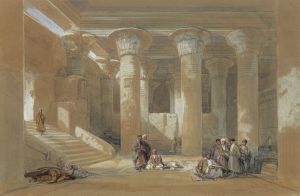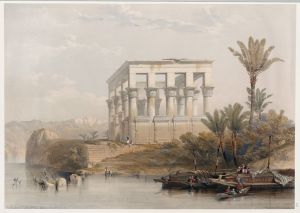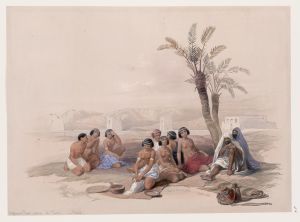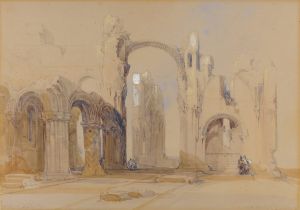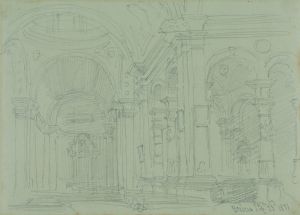
Front elevation of the Great Temple of Aboosimble [sic]. Nubia.
A hand-painted replica of David Roberts’s masterpiece Front elevation of the Great Temple of Aboosimble [sic]. Nubia., meticulously crafted by professional artists to capture the true essence of the original. Each piece is created with museum-quality canvas and rare mineral pigments, carefully painted by experienced artists with delicate brushstrokes and rich, layered colors to perfectly recreate the texture of the original artwork. Unlike machine-printed reproductions, this hand-painted version brings the painting to life, infused with the artist’s emotions and skill in every stroke. Whether for personal collection or home decoration, it instantly elevates the artistic atmosphere of any space.
"Front Elevation of the Great Temple of Aboosimble. Nubia" is a lithograph created by the Scottish artist David Roberts in the 19th century. This artwork is part of Roberts' renowned series of illustrations depicting scenes from Egypt and the Near East, which were published in the multi-volume work The Holy Land, Syria, Idumea, Arabia, Egypt, and Nubia. The lithographs were based on sketches and paintings Roberts made during his travels in the region between 1838 and 1839.
The lithograph portrays the façade of the Great Temple at Abu Simbel, one of the most iconic monuments of ancient Nubia, located in present-day southern Egypt near the border with Sudan. The temple was originally constructed during the reign of Pharaoh Ramesses II in the 13th century BCE. It is dedicated to the gods Amun, Ra-Horakhty, and Ptah, as well as to Ramesses himself. The façade is dominated by four colossal seated statues of the pharaoh, each approximately 20 meters tall, which are carved directly into the sandstone cliff. These statues are flanked by smaller figures representing members of Ramesses' family, including his wife Nefertari and several of his children.
David Roberts' depiction of the temple captures its grandeur and monumental scale, emphasizing the intricate details of the statues and the surrounding rock face. The lithograph also includes figures of local inhabitants and travelers, which serve to provide a sense of scale and context. Roberts' works were highly regarded for their accuracy and artistic quality, and they played a significant role in popularizing knowledge of ancient Egyptian and Nubian monuments in Europe during the 19th century.
The lithographs were produced by Louis Haghe, a Belgian lithographer, who worked closely with Roberts to translate his original sketches and paintings into printed form. The resulting prints were widely celebrated for their technical precision and vivid coloration, which brought the ancient sites to life for a European audience.
David Roberts' journey to Egypt and Nubia was part of a broader wave of European interest in the region during the 19th century, spurred by archaeological discoveries and the publication of travel accounts. His works remain an important historical record of these ancient sites as they appeared before modern restoration efforts and the construction of the Aswan High Dam, which led to the relocation of the Abu Simbel temples in the 1960s to prevent their submersion under Lake Nasser.
This lithograph is a testament to Roberts' skill as an artist and his dedication to documenting the architectural and cultural heritage of the ancient world. It continues to be appreciated for its artistic merit and its contribution to the study of Egyptology and the history of art.





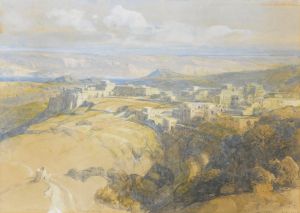
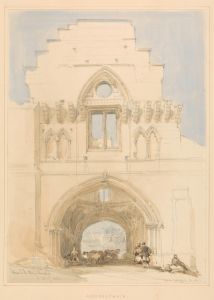
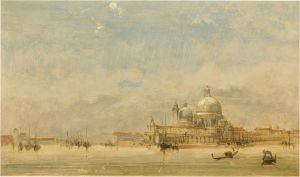
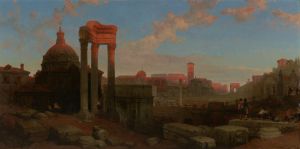
![Approach to the Temple of Wady Sabua [Wadi al-Sabua], Nubia.](/imgs/217463/s/david-roberts-approach-to-the-temple-of-wady-sabua-wadi-alsabua-nubia-41e9aa7e.jpg)
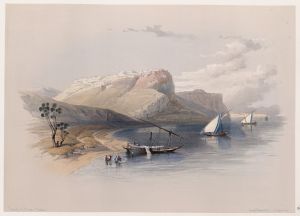
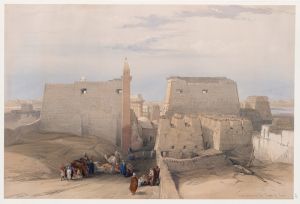
![Ruins of the Temple of Kardeseh [Qirtâsî], Nubia.](/imgs/217536/s/david-roberts-ruins-of-the-temple-of-kardeseh-qirtasi-nubia-cb337445.jpg)
![Temple of Wady Saboua [Wadi al-Sabua], Nubia.](/imgs/217551/s/david-roberts-temple-of-wady-saboua-wadi-alsabua-nubia-52e62db.jpg)
